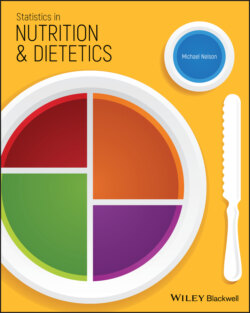Читать книгу Statistics in Nutrition and Dietetics - Michael Nelson - Страница 45
Analytical Studies
ОглавлениеThese include cohort and case‐control studies. Their primary characteristic is that they relate exposures in individuals (factors that are likely to influence the occurrence of disease or mortality within the population) to outcomes (disease or mortality rates). Analytical studies are usually based on observations relating to large numbers of people in the population (hundreds or thousands). They provide much stronger evidence of diet–disease relationships than descriptive studies. In terms of the Bradford Hill model of causality (Box 1.4), they provide evidence of temporal association and dose‐response. If blood or urine samples are collected, they may also provide evidence of a plausible physiological mechanism for causation. Detailed descriptions of these designs and their statistical analysis are given in epidemiological texts such as Rothman [9] or Margetts and Nelson [10].
Cohort studies are prospective in nature; they look forward in time, following a group of people who are free from the disease of interest at baseline. Relevant exposures are measured at baseline or time zero. Over time (usually years), the appearance of disease (morbidity), or relevant changes in blood or urine biochemistry, or nutrition‐related mortality, is monitored (Figure 1.6).
The risk of developing disease (or related outcomes) in the exposed group is compared with the risk of developing disease in the unexposed group. This is known as the Relative Risk.
FIGURE 1.6 Cohort study design.
In nutritional epidemiology, the meanings of ‘Exposed’ and ‘Unexposed’ are different from the meanings in infectious disease or occupational epidemiology. In infectious disease epidemiology, for example, a subject either is or is not exposed to a particular bacterium that can cause illness. In occupational epidemiology, a subject may be classified either as exposed or not exposed to a potential risk factor (e.g. asbestos dust). In nutritional epidemiology, in contrast, variables are usually continuous – no one has a diet that does not contain energy or iron, for example. Subjects are therefore classified into bands of exposure. ‘Exposed’ might mean someone in the top half of the distribution of intake, and ‘Unexposed’ might mean someone in the bottom half. Of course, degrees of exposure may also be ascertained in other spheres of epidemiology, but in nutritional epidemiology it is the norm and forms the basis for most analysis of risk.
In cohort studies, the time sequence of cause and effect is not in question. There may be other factors, however, which over time, explain the apparent associations between the measures at baseline and the outcome measures collected years later (e.g. some individuals may gain more weight than others, or their socio‐economic status at follow‐up may not be the same as it was at baseline). The strength of cohort studies is that if these factors are measured at baseline and again at follow‐up, they can be taken into account in the analysis. The main disadvantage of cohort studies is the length of time it takes to accumulate relevant outcome measures in sufficient numbers of individuals, and the cost of collecting the measurements in hundreds or thousands of individuals over long periods of time.
Case‐control studies, in contrast, start by identifying a group of subjects with a given disease or condition. Controls are subjects who do not have the disease or outcome being investigated. They are matched individually with the cases for age and sex, and often for other variables such as smoking or BMI or income or occupation. The study then looks backward in time to measure exposures that are potentially causal (Figure 1.7).
Measures of exposure in the past are usually determined by asking cases and controls about their habits in the past using a questionnaire (although sometimes there are records of exposure, for example the type of work someone did, or hospital records of birth weight). The past exposures of the cases are then compared with the past exposures of the controls. The relevant statistical outcome is the Odds Ratio: what are the chances of being exposed and in the disease group compared with being exposed and in the non‐disease group. This is the best estimate of the Relative Risk, which cannot be measured directly in case‐control studies [9, 10].
Case‐control studies are much cheaper to carry out than cohort studies, but accurate measurements of past exposure are often difficult to collect. For example, asking someone what their diet was like 10 or 15 years ago is likely to be heavily influenced by the type of diet they consume now.
FIGURE 1.7 Case‐control study design.
